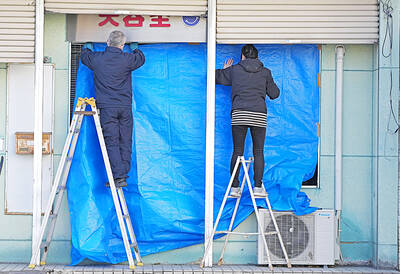China is increasingly confident in the accuracy and capability of its strategic missile force — much of it positioned within range of Taiwan, a new study by two associate professors at the US Naval War College said.
The People’s Liberation Army Second Artillery Force (PLASAF) has demonstrated that it can win in a regional conflict, “preventing US intervention therein,” they said.
The artillery force, which controls China’s land-based nuclear and conventional ballistic missiles and ground-launched cruise missiles “is an increasingly formidable force,” said the study, published this week by The Jamestown Foundation.
The study was written by Andrew Erickson and Michael Chase, associate professors at the War College.
“Substantial, rapid improvements have yielded not only a sophisticated, survivable arsenal of nuclear missiles capable of putting regional and continental US targets at risk, but also the world’s most numerous, diverse and comprehensive conventional, ballistic and cruise missile force,” they said.
As a result, the force has become “an increasingly dynamic and important component of the PLA,” they said.
In addition to increasing the numbers of its short-range ballistic missiles — more than 1,000 of them pointed at Taiwan — China has also improved their capabilities in range, accuracy and types of warhead.
“While cross-strait relations have reached a new zenith, Beijing still fears Taiwanese opposition to integration and strives to maximize related deterrent and coercive capabilities, while increasingly insisting that missiles are targeted principally at outside parties that might seek to intervene,” they said.
Potential targets for conventional missile strikes include command centers, communications facilities, radar stations, guided missile positions, air force bases, naval facilities and railway stations, the authors wrote.
Bridges, logistical facilities and energy production facilities could also be considered likely targets, they added.
“Beijing’s emphasis on deterring rival claimants in ‘Near Seas’ disputes and other potential adversaries from harming its homeland security and regional interests, and the US from intervening in such disputes, imposes new requirements on PLASAF,” the study said.
The study comes as author and China analyst Gordon Chang (章家敦) has published an article in The National Interest magazine saying that the recent visit to Taiwan of Chinese official Zhang Zhijun (張志軍) showed that Beijing was further away than ever from peaceful “unification.”
Chang said that Zhang’s visit and unfavorable reception could force China to make a “final push” to absorb Taiwan.
“It seems that the harder China tries to promote political union, the less the people on Taiwan want it,” Chang said.
“Beijing leaders evidently think their window for peaceful political integration with Taiwan is closing,” he said.
“Taiwan’s President Ma [Ying-jeou (馬英九)], who looks like he wants to stitch up a political deal with Beijing, has an approval rating hovering around 10 percent, about the same percentage who want unification with China,” says Chang.
He concludes that central Chinese leadership is worried that the incumbent’s plunging popularity will lead the KMT to lose its hold on power in the nation’s next presidential election in 2016.
“Therefore, China’s officials apparently think they will have to act while Ma remains in office, their last chance to grab sovereignty,” Chang said.

Taiwanese were praised for their composure after a video filmed by Taiwanese tourists capturing the moment a magnitude 7.5 earthquake struck Japan’s Aomori Prefecture went viral on social media. The video shows a hotel room shaking violently amid Monday’s quake, with objects falling to the ground. Two Taiwanese began filming with their mobile phones, while two others held the sides of a TV to prevent it from falling. When the shaking stopped, the pair calmly took down the TV and laid it flat on a tatami mat, the video shows. The video also captured the group talking about the safety of their companions bathing

US climber Alex Honnold is to attempt to scale Taipei 101 without a rope and harness in a live Netflix special on Jan. 24, the streaming platform announced on Wednesday. Accounting for the time difference, the two-hour broadcast of Honnold’s climb, called Skyscraper Live, is to air on Jan. 23 in the US, Netflix said in a statement. Honnold, 40, was the first person ever to free solo climb the 900m El Capitan rock formation in Yosemite National Park — a feat that was recorded and later made into the 2018 documentary film Free Solo. Netflix previewed Skyscraper Live in October, after videos

Starting on Jan. 1, YouBike riders must have insurance to use the service, and a six-month trial of NT$5 coupons under certain conditions would be implemented to balance bike shortages, a joint statement from transportation departments across Taipei, New Taipei City and Taoyuan announced yesterday. The rental bike system operator said that coupons would be offered to riders to rent bikes from full stations, for riders who take out an electric-assisted bike from a full station, and for riders who return a bike to an empty station. All riders with YouBike accounts are automatically eligible for the program, and each membership account

A classified Pentagon-produced, multiyear assessment — the Overmatch brief — highlighted unreported Chinese capabilities to destroy US military assets and identified US supply chain choke points, painting a disturbing picture of waning US military might, a New York Times editorial published on Monday said. US Secretary of Defense Pete Hegseth’s comments in November last year that “we lose every time” in Pentagon-conducted war games pitting the US against China further highlighted the uncertainty about the US’ capability to intervene in the event of a Chinese invasion of Taiwan. “It shows the Pentagon’s overreliance on expensive, vulnerable weapons as adversaries field cheap, technologically